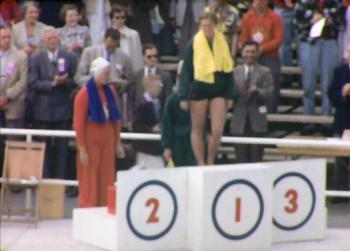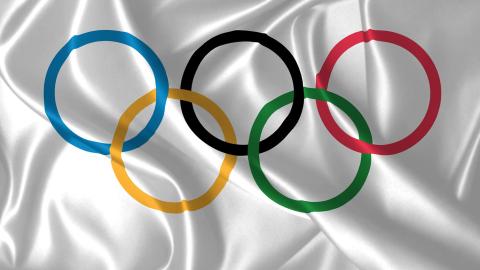

Preserving the golden era of Australian swimming
The golden era of Australian swimming

Two of Australia’s greatest swimmers, Olympic champions Jon Henricks and Lorraine Thurlow (nee Crapp), recently donated a never-before-seen film to the NFSA.
This film was shot during their 1954 North American tour, and it includes rare footage of the Australian team’s participation in the British Empire and Commonwealth Games in Vancouver, Canada.
The film also follows the men’s swimming team on a road trip down the California coast – including San Francisco, Los Angeles and San Diego – during which they participated in exhibition events.
THE VANCOUVER GAMES
Australia’s team was, at the time, the second largest to represent the country at an overseas Games. Our 73 athletes won 48 medals, including 20 gold.
Jon Henricks won three medals: gold for 110 yards freestyle, 4×220 yards freestyle relay (with G Chapman, R Aubrey, D Hawkins), and 330 yards medley relay (with C Weld and D Hawkins).
Lorraine Crapp also won three: gold for 110 yards freestyle and 440 yards freestyle; and bronze for the 330 yards medley relay (with D Knight, J Grier).
The following four clips are highlights from the 75-minute film, and are narrated by Jon Henricks and his friend and fellow swimming legend, John Devitt.
BILL HOLLAND, AMATEUR FILMMAKER
The 16mm film was shot by Bill Holland, then Secretary of the Queensland Amateur Swimming Association (QASA), and Manager of the Australian swimming team in Vancouver.
In the early 1980s, Mr Holland decided to show the film to all the members of the 1954 men’s swimming team. He visited Jon Henricks in the USA, and even attended his Oscar night party. But Mr Holland died unexpectedly during this visit, in Jon’s home.
Jon returned the ashes to Mr Holland’s widow in Brisbane. She asked Jon to keep the film, and he had VHS copies made and sent them to the rest of the team.
Years later Jon was getting ready to move house, and rediscovered the film. A DVD version was created, and shown at the Games 60th anniversary reunion in Vancouver in 2014.
Jon’s good friend and fellow swimming champion John Devitt told him the NFSA might be interested in preserving the film. With help from sports journalist Ian Hands, the swimmers contacted us and decided to donate the 16mm original. They also invited fellow Vancouver 1954 medallist Lorraine Thurlow (nee Crapp) to join Henricks as a co-donor.
We spoke with Mr Henricks and Mrs Thurlow about the film, and why they felt it was important to preserve it for future generations of aspiring swimmers and athletes.

How do you feel about the film being preserved by the NFSA?
Lorraine: [The film is] a marvellous thing. There’s very little record of what we did in that period of time.
What do you remember about that trip?
Lorraine: It was my first big overseas trip, and my first time in Canada. The men’s cycling team took us under their wing; they were really great. Otherwise we would’ve been overwhelmed. I also remember the mountains behind the pool; it was beautiful!
What about the competition itself?
Lorraine: Team spirit was great. We were very young. What we did in Vancouver 1954 was the beginning of the golden era of Australian swimming, leading up to Melbourne 1956. I have old photos from the Games… there is one of me in the pool with [Canadian swimmer] Virginia Grant after the 110 yard freestyle event. She was expected to win, and I was the underdog.
Why is this film important, and why did you donate it to the NFSA?
Jon: Bill Holland’s love of swimming, and his diligence in making the film, should not be lost. He loved swimming and he gave a lot to the sport, with no reward, and I felt it would be a heinous crime to just throw that film away.
This film represents some of the best performances Australia had had at the Games, not just in swimming but also track and field – you may remember the ‘miracle mile, which was so beautifully filmed by Bill. That footage, in colour, I don’t think is available anywhere else. It was the first time the four-minute mile was broken by two men, and it started an era.

What is the legacy of the 1954 Commonwealth Games?
Jon: Vancouver 1954 set our swimmers on a path to the arguably best swimming team that Australia ever produced. We managed to capture every freestyle and relay event, both men and women, in Melbourne 1956. I don’t think that feat has been equalled in any Olympics since.
In addition, I must say that my father had come down with the idea of shaving down before a swimming meet.
I believe that the Australian team, both at Vancouver 1954 and Melbourne 1956, were the only ones that shaved and tapered before a meet, and that gave us an undoubted edge over the rest of the world.
Where did the idea come from?
Jon: My brother-in-law is a sailor, and he would clean and polish the hull of his boat to make it faster. My father saw that and he said to me, ‘Jesus, Henricks, we’ve got to clean your hull!’
The National Film and Sound Archive of Australia acknowledges Australia’s Aboriginal and Torres Strait Islander peoples as the Traditional Custodians of the land on which we work and live and gives respect to their Elders both past and present.


